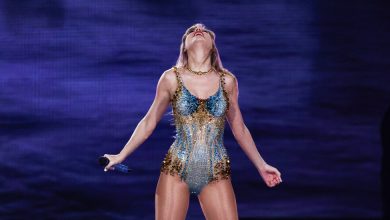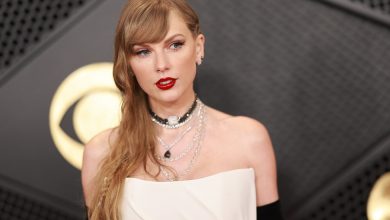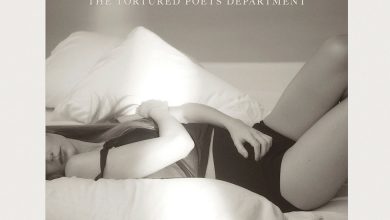A Dance to the Music of Time and T.S. Eliot

In its beginning is its end. In its end is its beginning. Those tail-eating lines, paraphrased from “Four Quartets,” the poem by T.S. Eliot, tell you the outer shape of “Four Quartets,” the much-acclaimed dance by Pam Tanowitz that had its New York City debut at the Brooklyn Academy of Music on Thursday.
The circular structure is a formal idea with philosophical resonance. If you’re going to make a dance to a long and difficult poem, it makes sense to take Eliot’s phrases about beginnings and endings as guideposts, almost as stage directions. But the success of Tanowitz’s work — why it doesn’t sink under the weight of the poem’s paradox-laden ruminations on time, pattern, history and memory — lies as much in the dance’s independence from the text as in its coordination.
There’s so much going on here, so many layers. The actress Kathleen Chalfant recites the poem matter-of-factly, with a voice of experience that earns the occasional laugh. For a while, her voice is the only sound, and when the music enters — a spectral score of harp and strings by Kaija Saariaho, played live by members of the orchestral collective the Knights — it’s nearly an intrusion. But soon the ear adjusts to the music’s buzzing and sliding as another part of this world.
Already, there is much to see. Clifton Taylor’s exquisite set and lighting design translates paintings by Brice Marden into space and motion. In one painting of luminous gates and T-shapes, the black strips are holes into which the dancers disappear. Some of the paintings are on wheeled panels, translucent screens that the dancers move to reshape the stage area, barriers to go behind and around. Scrims drop and rise, a play of opacity and transparency, shadow and light, seeing and seeing through that’s echoed even in the costumes: diaphanous pajamas by Reid Bartelme and Harriet Jung.
All of this is right for the poem and for Tanowitz’s choreography. Her complex and irregular sense of form — now still or spare, now quick and insistent; solos and duets emerging in and out of sudden gatherings; action that overlaps and spills off the edges of the stage — is complemented rather than crowded by the other elements.
The viewer is left with a freedom to focus and drift. As the music sinks and resurfaces, images and ideas from the poem (some direct and sensuous, some baffling) advance and recede in your imagination, or just in your attention. So do recurrent images in the dance: a running-in-place with heels kicked up behind, head back, one arm reaching high; a deeply tilted arabesque adorned with a quaking, shimmering hand.
The infrequent correspondences between text and dance — or the rare synchronicity of a musical plunk and the turn of a head — ring like bells during meditation. The many scattered allusions to dance and music in the poem, surely the inspiration for the project, allow Tanowitz to treat the text tangentially, trusting in both set and serendipitous links.
Those ruminations of Eliot inflect Tanowitz’s patterns, making the return of a dance phrase even more like a memory. The poem and the paintings help the dance from going too dry, and the dance and the paintings save the poem from some of its obscurity. A viewer who worries, as Eliot’s narrator does, about having the experience but missing the meaning, need not worry. There’s a superabundance of both.
At the core of that experience are the 10 unostentatiously extraordinary dancers. And it’s like an Easter egg when Tanowitz herself appears, at first apart and then joining the others. A late entrance, in one of those take-it-or-leave-it correspondences, comes at the moment in the poem when a “dead master” poet arrives.
When “Four Quartets” debuted at Bard College in 2018, it seemed a happy story of an admired but underfunded choreographer finally being given opera-house resources and making the most of them. In this sense, although Tanowitz’s aesthetic is more in the line of Merce Cunningham, her “Four Quartets,” with its scrims and circles and scale, reminded me of Mark Morris’s “L’Allegro, il Penseroso ed il Moderato,” his 1988 breakthrough to the big time (which returns to the Brooklyn Academy next month).
That parallel felt even stronger at the Brooklyn Academy, especially since Tanowitz has now broken through, with commissions from New York City Ballet, the Royal Ballet, the Martha Graham company and just about everybody else. But this work, with her own stable of dancers, is better, an argument for more large-scale independent productions.
The world around “Four Quartets” has changed since 2018. Different phrases in the text now jump out: “The whole earth is our hospital,” for one. But this is a production that, like the words in it, takes a long view. It turns out that a poem about how “all time is eternally present” is a good poem for a dance.
Four Quartets
Through Saturday at the Brooklyn Academy of Music, bam.org.



